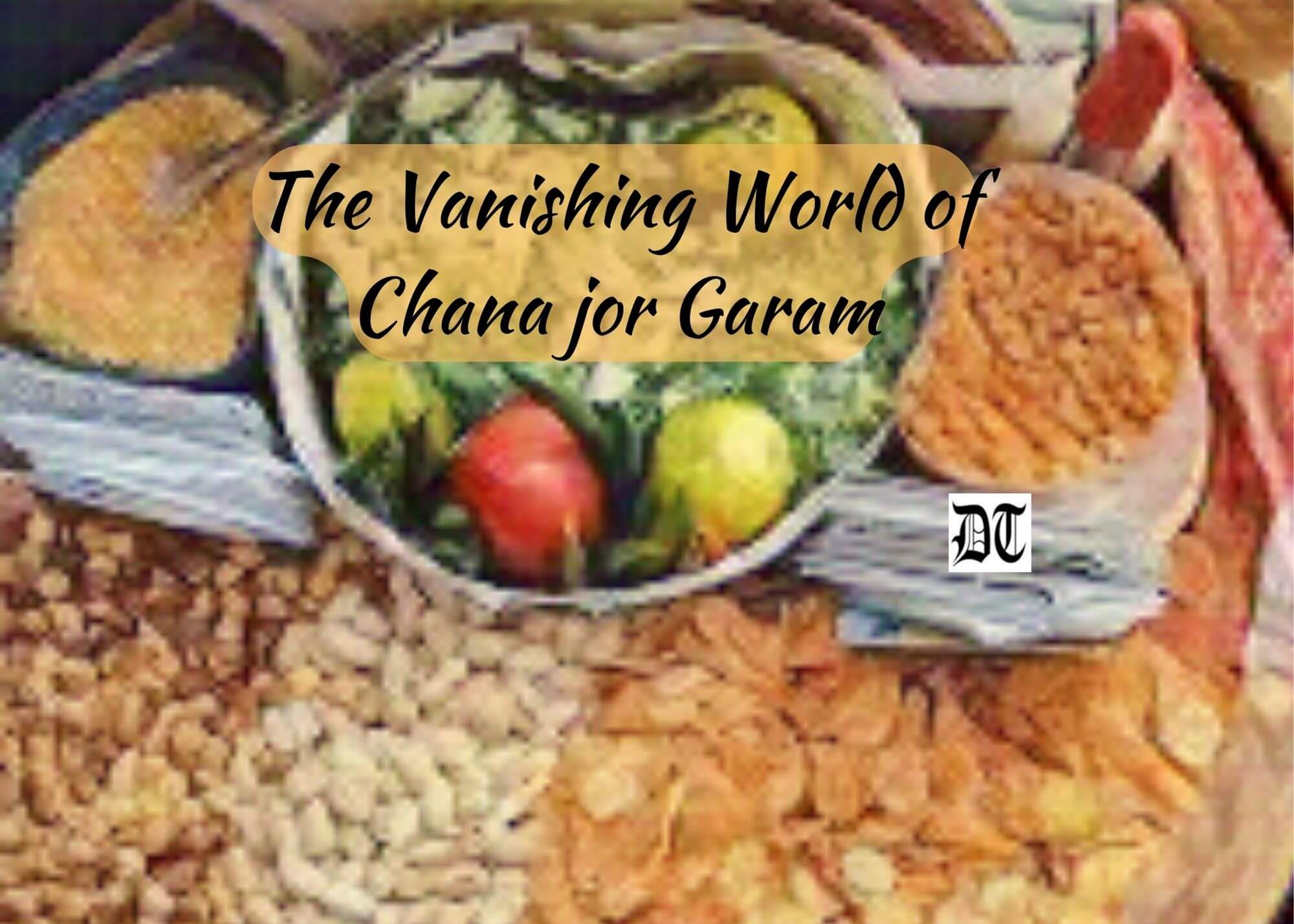Chana jor garam is a part of our childhood. The vendors would sing and perform, witty songs, full of repartee and tomfoolery. Arindam talks with two chana jor garam vendors. They don’t know that they are selling chana jor. They call it murmura. The songs too are forgotten – either vanishing or dead. Different Truths presents an interesting account of the ethnic snack that has been celebrated in Bollywood.
Tufanideen is probably someone you would meet in a Hindi storybook. But I met him, in flesh and blood, in swanky Civil Lines market of Allahabad. He sells chana jor (also spelled chana zor), an ethnic snack that was popular during our childhood days.
Bollywood popularised chana jor garam. There are three interesting songs, two from old films, Bandhan (1939). The second old song is by Kishore Kumar and Samshad Begum. They sang chana jor garam in the film, Naya Andaz (1956). The third song is from Kranti (1981), immortalised by Mohd. Rafi, Lata Mangeshkar and Nitin Mukesh. This version of the song gives a patriotic twist to the snack, beautifully. Chana jor becomes a metaphor for freedom fighters about to be hung to death.
https://www.youtube.com/watch?v=M2EaJYbIUH0
When I approached Tufanideen, in his thirties, and wanted to talk to him, he turned pale. His eyes popped out and he looked at me as if I was an alien.
I smiled and put him in ease. I asked what he was selling. He said that this is known as ‘murmura’. His clients asked him for murmura, not chana jor.
I bought chana jor and started talking with him. Slowly, he opened up. He said that he hailed from Gazipur. Without much education, he sold chana jor, mixing it with chopped onions, green chillies, chopped coriander leaves, mustard oil and some masalas. He earned about Rs 1000 a day, selling chana jor for about Rs 1500. The cost of the material is roughly one third.
https://www.youtube.com/watch?v=O-41YxXIXfk
He explained how it is made. Black gram is soaked in water for two nights. Then two or three grams are taken at a time and flattened with a clean hammer on the grinding stone (seel). It’s a strenuous job. After that the flattened black grams are deep fried in mustard oil. The oil is strained and the chana-jor is kept in packets, ready to be mixed with condiments and spices, and sold.
Tufanideen, had no tufan (storm) in him. He was reticent and shy. A very private person, I let him be. He got busy with his customers.
About 500 yards away from Tufanideen’s khomcha, a small stall that can be carried on head, which had a dibri (kerosene lamp), I located another chana jor garam seller with a similar khomcha.
Vijay, 44-years old, was also from Gazipur. The eldest son of the family, he had to start earning as a boy. When he was an 8-year lad, he began working in the carpet industry. In a couple of years, he was one of the best carpet weavers.
The knife is so sharp that one might lose a finger or two…
He explained that there is a wood frame with woolen strings taut on it. With nimble fingers he would tie fine knots and cut off the excess wool with a small, sharp knife. The knife is so sharp that one might lose a finger or two, if not alert. Few years into hand weaving carpets, tying knots and cutting off wool was more of a reflex for him.
Others in his family were also engaged in the carpet weaving business. But, the strenuous work has poor pay. He, therefore, chose to be a murmura (read chana jor) vendor.
Vijay was more smiles and full of easy camaraderie.
The method of making chana jor that Vijay told tallied with what Tufanideen told me a while back. He was hedgy about his daily earnings but was happy to share the personal details of his life.
Vijay was more smiles and full of easy camaraderie.
Both of them said that they no longer sing the witty songs that chana jor garam sellers were famous for. Vijay asked me, “Gana, kaisa gana gaun, Sahib?” (Song, what songs should I sing, sir?). They don’t know anything about the legacy of the chana jor garam songs. It was clear that the folk songs were vanishing, if not dead.
He sang funny couplets in a nasal tone.
We may give them the white margin as it is not their family business. That’s what both of them said.
I recall, in my childhood, there was a chana jor garam seller. He sang funny couplets in a nasal tone. We would ask him to sing the entire song before we bought plenty of chana jor. We lived in railway colony. There were hordes of children. Many, like me, lived in a joint family, with cousins, uncles and aunts.
Here’s an example that I stumbled upon, in YouTube, which is very near what we used to hear as children:
https://www.youtube.com/watch?v=e3A-UHEtI_U
The chana jor garam seller would amuse us all with his songs and dances. There were lots of tomfoolery, making faces and rolling eyes. We children would roll in laughter. Adults too would be amused. He brought alive the child in all, from nine to ninety.
A friend, Alok, said, “You may locate a few chana jor garam sellers in the city, these days. It’s a fad and fashion to serve and eat ethnic food in the Hindi heartland. People would easily pay Rs 10/- for a little chana-jor in posh Civil Lines. Villagers do not have that kind of money.”
These folk songs are a dying art form
He added, “These days, the rich and famous host bati-chokha parties; it was a staple diet of the poor. In the villages, even during fairs, we hardly find any chana jor garam vendors these days.”
These folk songs are a dying art form. Our children would never hear the witty songs, full of repartee and tomfoolery that we had witnessed in our younger days. Perhaps there only reference would be the few songs from Bollywood, which to them might appear more imaginary than real.

Picture design Anumita Roy
Links from Youtube.





 By
By
 By
By
 By
By
I enjoyed reading this highly textuured story about a folk tradition in which music played as important a role as the food itself! How unique and charming a practice this was!
Very true, Joyce. It’s sad that the rich tradition is under threat and on the verge of extinction. Thanks for the encouraging words.
thoroughly enhjoyed reading this…
A thoroughly enjoyable read. Brought back memories of my school days when after the school hours, we too had our own chana Jor garam seller who has different kinds of churan also on offer.
That’s right. So many things of the past are vanishing and dead, Sir.
Thank you preserving this memory in your fine and vivid narrative!
Thank you so much, Azam Gill ji